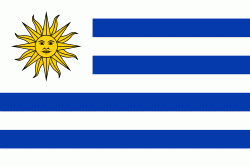Paysandú Airport (Paysandú Airport)
Tydeo Larre Borges International Airport (Aeroporto Internacional Tydeo Larre Borges) is a general aviation airport serving Paysandú, capital of the Paysandú Department of Uruguay. The airport is 3 km south of the city.
It is named in honour of Tydeo Larre Borges, a pioneer of Uruguayan and international aviation, who was the first South-American aviator to cross the South Atlantic.
The airport has been served by government air service provider TAMU (es) and charter operator Aviasur.
The Gualeguaychu VOR-DME (Ident: GUA) is located 47.8 nmi southwest of the airport. The Paysandu non-directional beacon (Ident: PN) is located on the field.
* Transport in Uruguay
* List of airports in Uruguay
* Transport in Uruguay
* List of airports in Uruguay
It is named in honour of Tydeo Larre Borges, a pioneer of Uruguayan and international aviation, who was the first South-American aviator to cross the South Atlantic.
The airport has been served by government air service provider TAMU (es) and charter operator Aviasur.
The Gualeguaychu VOR-DME (Ident: GUA) is located 47.8 nmi southwest of the airport. The Paysandu non-directional beacon (Ident: PN) is located on the field.
* Transport in Uruguay
* List of airports in Uruguay
* Transport in Uruguay
* List of airports in Uruguay
| IATA Code | PDU | ICAO Code | SUPU | FAA Code | |
|---|---|---|---|---|---|
| Telephone | Fax | ||||
| Home page |
Map - Paysandú Airport (Paysandú Airport)
Map
Country - Uruguay
 |
 |
| Flag of Uruguay | |
The area that became Uruguay was first inhabited by groups of hunter–gatherers 13,000 years ago. The predominant tribe at the moment of the arrival of Europeans was the Charrúa people, when the Portuguese first established Colónia do Sacramento in 1680; Uruguay was colonized by Europeans late relative to neighboring countries. The Spanish founded Montevideo as a military stronghold in the early 18th century because of the competing claims over the region. Uruguay won its independence between 1811 and 1828, following a four-way struggle between Portugal and Spain, and later Argentina and Brazil. It remained subject to foreign influence and intervention throughout the 19th century, with the military playing a recurring role in domestic politics. A series of economic crises and the political repression against left-wing guerrilla activity in the late 1960s and early 1970s put an end to a democratic period that had begun in the early 20th century, culminating in the 1973 coup d'état, which established a civic-military dictatorship. The military government persecuted leftists, socialists, and political opponents, resulting in deaths and numerous instances of torture by the military; the military relinquished power to a civilian government in 1985. Uruguay is today a democratic constitutional republic, with a president who serves as both head of state and head of government.
Currency / Language
| ISO | Currency | Symbol | Significant figures |
|---|---|---|---|
| UYU | Uruguayan peso | $ | 2 |
| ISO | Language |
|---|---|
| ES | Spanish language |















